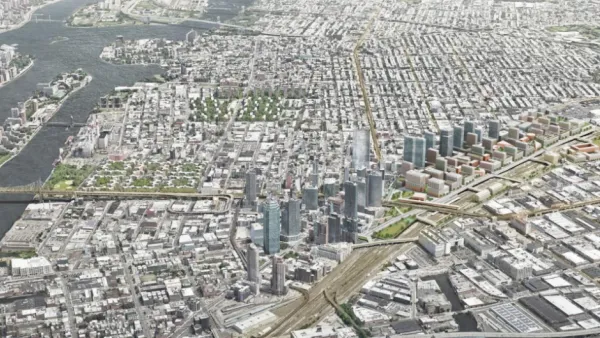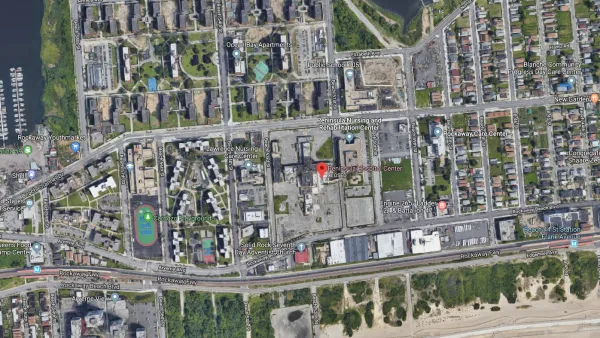It's known as the Iron Triangle, though some call the sewerless 13-block collection of auto junkyards just east of Shea Stadium an eyesore and disgrace. A controversial application of eminent domain is at the heart of the $3 billion makeover plan.
From NYT, July 8, 2007:
It is "an astonishingly ramshackle industrial shantytown, something out of "Mad Max," bereft of most city services. The unlit streets are blocked by 40-foot-long puddles of standing water, filling truck-length potholes that traffic must creep around. Since there are no sidewalks, pedestrians share the street with cars; nor are there sewer lines for toilets, and most of the buildings are jerry-rigged structures of corrugated aluminum."
From Queens Chronicle:
"In an agonizing vote that took 5 1/2 hours to reach, (Queens) Community Board 7 members voted 20-15 (on July 1) to approve the city's controversial Willets Point development plan.
The city wants to redevelop the 60-acre area now occupied by car junkyards and businesses into a mixed-use area including 5,500 housing units... There are no sewers or sidewalks there now, continuing to draw the ire of business owners, who say that if the city put in those improvements, the area would evolve on its own.
Seventy speakers were scheduled to give their opinion on the project. They were equally divided among those who supported the plan - union leaders and environmentalists - and those who opposed it - workers and owners plus proponents of more affordable housing.
The issue of the city using eminent domain to take properties did not sit well with many community board members and certainly not with the business owners. Although the city has said it is working in good faith to find new locations for the 250 businesses in Willets Point, so far only two landowners have agreed to sell."
"Without a complete cleanup of the soils beneath Willets Point, all our efforts at cleaning up the surrounding waterways will come to naught," said one advocate for redevelopment.
From NYT (May 29, 2005):
The Iron Triangle "was supposed to be part of Flushing Meadows, home of the Mets and the U.S. Open tennis tournament and the site of two world's fairs. But because of the machinations of the master builder Robert Moses and the oratorical skills of a young lawyer named Mario M. Cuomo, a strategically located part of Queens one-tenth the size of Central Park became a junkyard, a veritable wall of concrete, oil and scrap metal that prevents development along the Flushing waterfront.
On a clear day, the stretch of car repair shops, scrap metal depots and waste treatment plants resembles nothing so much as a scene from "The Road Warrior." The thoroughfares are blistered with holes like the surface of the moon, and the wind churns up clouds of dust that blow through 70 acres of scrap metal, mounds of contaminated earth and abandoned cars of every description."
FULL STORY: C.B. 7 Approves Willets Pt. Plan

National Parks Layoffs Will Cause Communities to Lose Billions
Thousands of essential park workers were laid off this week, just before the busy spring break season.

Retro-silient?: America’s First “Eco-burb,” The Woodlands Turns 50
A master-planned community north of Houston offers lessons on green infrastructure and resilient design, but falls short of its founder’s lofty affordability and walkability goals.

Delivering for America Plan Will Downgrade Mail Service in at Least 49.5 Percent of Zip Codes
Republican and Democrat lawmakers criticize the plan for its disproportionate negative impact on rural communities.

Test News Post 1
This is a summary

Test News Headline 46
Test for the image on the front page.

Balancing Bombs and Butterflies: How the National Guard Protects a Rare Species
The National Guard at Fort Indiantown Gap uses GIS technology and land management strategies to balance military training with conservation efforts, ensuring the survival of the rare eastern regal fritillary butterfly.
Urban Design for Planners 1: Software Tools
This six-course series explores essential urban design concepts using open source software and equips planners with the tools they need to participate fully in the urban design process.
Planning for Universal Design
Learn the tools for implementing Universal Design in planning regulations.
EMC Planning Group, Inc.
Planetizen
Planetizen
Mpact (formerly Rail~Volution)
Great Falls Development Authority, Inc.
HUDs Office of Policy Development and Research
NYU Wagner Graduate School of Public Service




























